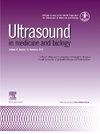Increased Mechanical Index Improves Shear Wave Elastography: Pilot Study of Signal Enhancement
IF 2.4
3区 医学
Q2 ACOUSTICS
引用次数: 0
Abstract
Objective
Monitoring liver stiffness is essential for managing chronic liver disease, which poses a major public health challenge. Shear wave elastography (SWE), a non-invasive ultrasound-based technique, is commonly used to quantify liver stiffness. However, its performance can be compromised in individuals with higher body mass indices (BMIs) due to increased ultrasound absorption and distortion. Increasing the intensity of the ultrasound push beam could potentially improve signal quality, but regulatory limits currently restrict this due to safety concerns. This pilot study investigated the efficacy of increasing the push pulse mechanical index (MI) from a conventional value of 1.4 to 2.5 toward improving signal quality, and reducing measurement variability and failure rates.
Methods
Healthy volunteers (22) stratified by BMI underwent SWE with conventional and increased MI push pulses. The resulting data were processed with conventional SWE algorithms, and the signal and measurement quality of the results were analyzed.
Results
We found that the higher MI improved the signal-to-noise ratio by 4.6 dB (10-4, 95% confidence interval: 3.4–5.8 dB) and reduced the measurement's coefficient of variation by 13% (10-4, 95% confidence interval: 5.8%–20.3%), enhancing the success rate of SWE examinations, especially for subjects with a BMI over 30. Liver function tests before and after the SWE examinations showed no signs of bioeffects or harm based on serum biomarkers.
Conclusion
These results suggest that increasing the push pulse MI to 2.5 improves the diagnostic utility of SWE, particularly for individuals with a higher BMI, without introducing significant additional risk. This approach could further enhance SWE's vital role in the monitoring of chronic liver disease at a population scale.
增加的力学指数改善了横波弹性成像:信号增强的初步研究。
目的:监测肝脏僵硬度对慢性肝病的治疗至关重要,慢性肝病是一项重大的公共卫生挑战。剪切波弹性成像(SWE)是一种非侵入性超声技术,通常用于量化肝脏硬度。然而,对于身体质量指数(bmi)较高的个体,由于超声吸收和畸变增加,其性能可能会受到损害。增加超声波推进束的强度可能会潜在地改善信号质量,但由于安全考虑,目前的监管限制限制了这一点。该试验研究了将推脉冲机械指数(MI)从常规值1.4提高到2.5的效果,以改善信号质量,降低测量变异性和故障率。方法:按BMI分层的健康志愿者(N=22)接受常规和增加心肌推脉冲的SWE。采用常规SWE算法对所得数据进行处理,并对结果的信号质量和测量质量进行分析。结果:我们发现,较高的MI使信噪比提高了4.6 dB (p-4, 95%置信区间:3.4-5.8 dB),并使测量的变异系数降低了13% (p-4, 95%置信区间:5.8%-20.3%),提高了SWE检查的成功率,特别是对于BMI超过30的受试者。根据血清生物标志物,SWE检查前后的肝功能测试未显示出生物效应或危害的迹象。结论:这些结果表明,将推脉MI增加到2.5可以提高SWE的诊断效用,特别是对于BMI较高的个体,而不会引入显著的额外风险。这种方法可以进一步增强SWE在人群范围内监测慢性肝病中的重要作用。
本文章由计算机程序翻译,如有差异,请以英文原文为准。
求助全文
约1分钟内获得全文
求助全文
来源期刊
CiteScore
6.20
自引率
6.90%
发文量
325
审稿时长
70 days
期刊介绍:
Ultrasound in Medicine and Biology is the official journal of the World Federation for Ultrasound in Medicine and Biology. The journal publishes original contributions that demonstrate a novel application of an existing ultrasound technology in clinical diagnostic, interventional and therapeutic applications, new and improved clinical techniques, the physics, engineering and technology of ultrasound in medicine and biology, and the interactions between ultrasound and biological systems, including bioeffects. Papers that simply utilize standard diagnostic ultrasound as a measuring tool will be considered out of scope. Extended critical reviews of subjects of contemporary interest in the field are also published, in addition to occasional editorial articles, clinical and technical notes, book reviews, letters to the editor and a calendar of forthcoming meetings. It is the aim of the journal fully to meet the information and publication requirements of the clinicians, scientists, engineers and other professionals who constitute the biomedical ultrasonic community.

 求助内容:
求助内容: 应助结果提醒方式:
应助结果提醒方式:


